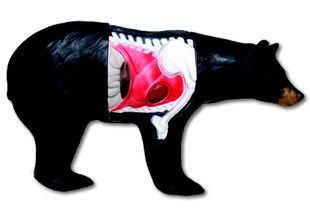Post by POINTY STICKS on Aug 1, 2007 14:10:37 GMT -4
Successful Bear Hunting with Bow and Arrow
Seeing how bear hunting is growing in popularity in Nova Scotia and more and more archers are trying it for the first time Here is some information to help assist you with your hunt.
Harvesting bear with archery tackle means not only making a lethal shot, but recovering the animal for use. Here are some tips for making sure you bring home your bear.
Know your equipment and practise. Most bear hunters shoot from elevated stands, which affects arrow flight and aiming point. Spend time shooting from an elevated position before you hunt.
Avoid very light arrows which lack the momentum to ensure complete penetration of a bear. Your bow needs to have enough draw weight and speed for the job, but you also need an arrow heavy enough to be lethal. Remember, you can’t make up in bow speed what you lack in arrow weight. Penetration is the key to a clean harvest, and heavier arrows penetrate more deeply.
Keep broadheads razor-sharp. If you can’t shave with it, don’t hunt with it.
Keep shots short to ensure the arrow carries enough energy to give you a complete pass-through. Stay inside 25 yards.
Mechanical broadheads open reliably only on broadside shots. Wait for a side-on presentation if you use these broadheads.
Traditional archers should avoid two-bladed broadheads while bear hunting. Bear fat can block a slit made with a two-blade broadhead—use a three-blade to ensure your best blood trail.
Know the terrain around your stand. This will help you recover your bear.
Know bear anatomy. A good shot on a deer can be a bad shot on a bear. Be sure.
Be aware of the animal’s movements as you prepare for the shot. If the foreleg is coming back, don’t release an arrow. The heavy shoulder blade of your quarry can easily deflect your shot. Be aware of the whole animal, but shoot only at that dime-sized aiming spot.
Getting a good trail means achieving a complete pass-through. Visualize the exit path of the arrow before shooting and release only when you have a clear path.
After the shot, watch and listen carefully for sight and sound of your fleeing bear. Make mental notes of the direction of the bear’s travel and last sounds.
Bears often don’t leave tracks! You’ll need a good blood trail to recover your harvest, so ensure that pass-through shot. Remember, ethical hunting means both a clean kill and recovery of your game.
Good—and successful—bear hunting!
Bowhunters Association of Nova Scotia
Nova Scotia Federation of Anglers and Hunters


Seeing how bear hunting is growing in popularity in Nova Scotia and more and more archers are trying it for the first time Here is some information to help assist you with your hunt.
Harvesting bear with archery tackle means not only making a lethal shot, but recovering the animal for use. Here are some tips for making sure you bring home your bear.
Know your equipment and practise. Most bear hunters shoot from elevated stands, which affects arrow flight and aiming point. Spend time shooting from an elevated position before you hunt.
Avoid very light arrows which lack the momentum to ensure complete penetration of a bear. Your bow needs to have enough draw weight and speed for the job, but you also need an arrow heavy enough to be lethal. Remember, you can’t make up in bow speed what you lack in arrow weight. Penetration is the key to a clean harvest, and heavier arrows penetrate more deeply.
Keep broadheads razor-sharp. If you can’t shave with it, don’t hunt with it.
Keep shots short to ensure the arrow carries enough energy to give you a complete pass-through. Stay inside 25 yards.
Mechanical broadheads open reliably only on broadside shots. Wait for a side-on presentation if you use these broadheads.
Traditional archers should avoid two-bladed broadheads while bear hunting. Bear fat can block a slit made with a two-blade broadhead—use a three-blade to ensure your best blood trail.
Know the terrain around your stand. This will help you recover your bear.
Know bear anatomy. A good shot on a deer can be a bad shot on a bear. Be sure.
Be aware of the animal’s movements as you prepare for the shot. If the foreleg is coming back, don’t release an arrow. The heavy shoulder blade of your quarry can easily deflect your shot. Be aware of the whole animal, but shoot only at that dime-sized aiming spot.
Getting a good trail means achieving a complete pass-through. Visualize the exit path of the arrow before shooting and release only when you have a clear path.
After the shot, watch and listen carefully for sight and sound of your fleeing bear. Make mental notes of the direction of the bear’s travel and last sounds.
Bears often don’t leave tracks! You’ll need a good blood trail to recover your harvest, so ensure that pass-through shot. Remember, ethical hunting means both a clean kill and recovery of your game.
Good—and successful—bear hunting!
Bowhunters Association of Nova Scotia
Nova Scotia Federation of Anglers and Hunters


